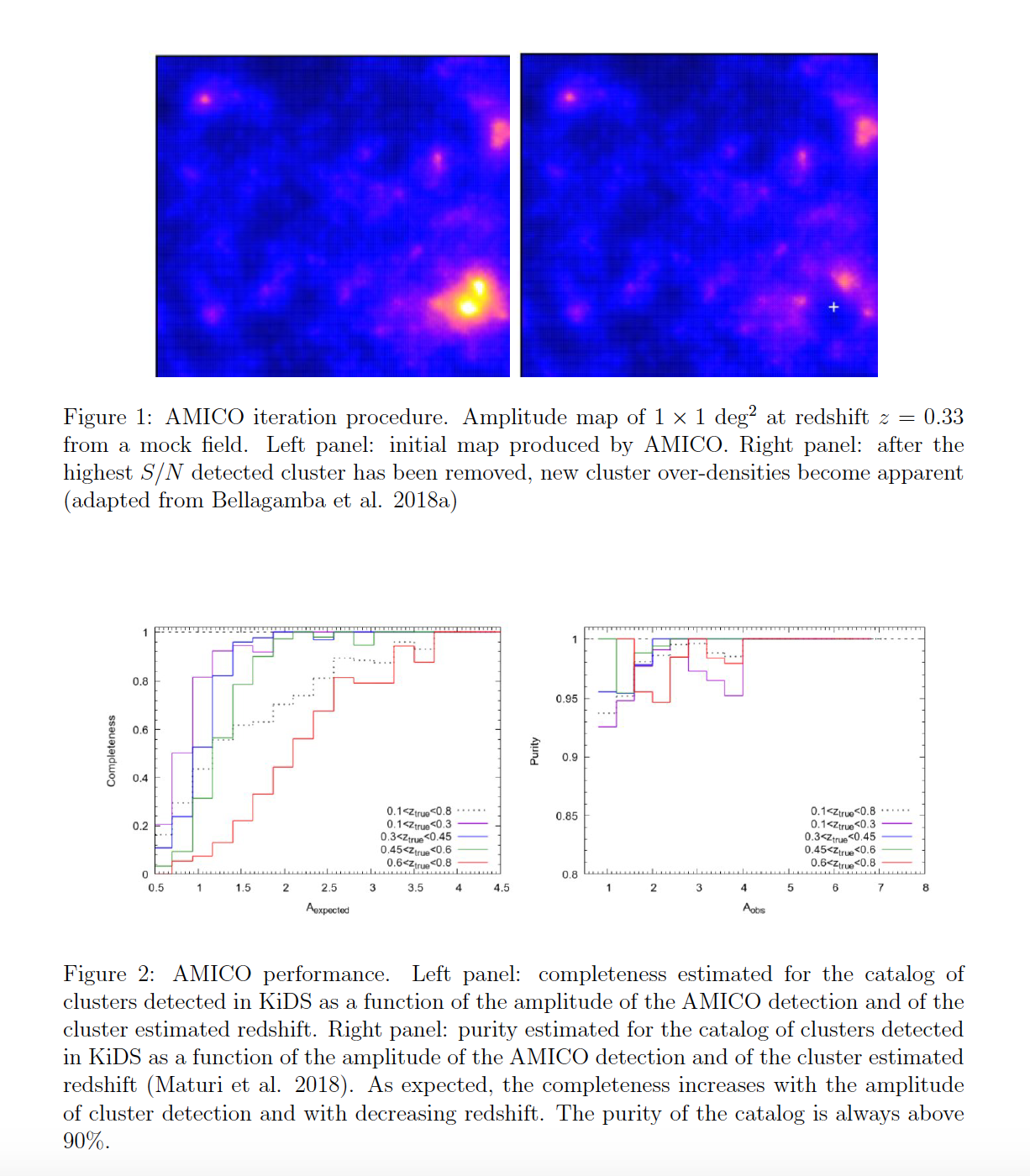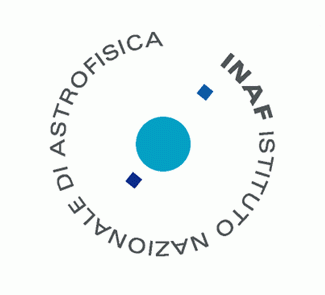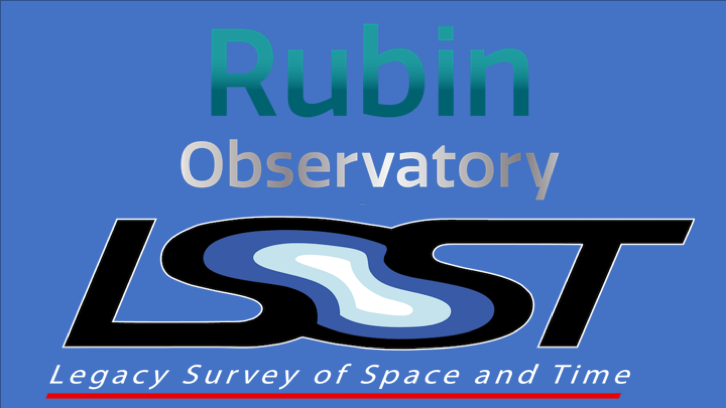Scientific Objectives
The aim of the LSST-Italy Clusters of Galaxies collaboration is to build a catalog of clusters of galaxies up to redshift z =1.5 to constrain cosmological models and the internal structure of clusters. To achieve our goals we need to develop tools to 1) identify clusters of galaxies, 2) measure cluster number density and spatial distribution, 3) determine how these observables depend on cosmological models, and 4) determine the total, stellar, and diffuse plasma distributions within clusters.
1) We have developed a clusters of galaxies detection algorithm, AMICO (Adaptive Matched Identifier of Clustered Objects), based on the optimal filtering technique, which allows to maximize the signal-to-noise (S/N) ratio of the data (Bellagamba et al. 2018a). One of novelties of AMICO is its iterative approach. When a cluster is detected, it can be removed from the data-set to allow a deeper search of otherwise undetectable lower S/N clusters, because hidden by their prominent neighbors (See Fig. 1). The AMICO approach provides excellent deblending of close-by and aligned clusters.
Runs of AMICO on simulated data-sets have allowed to constrain the selection function of this code in terms of purity and completeness of the clusters catalog as a function of the cluster z and S/N (see Fig. 2), as well as to calibrate the mass-observable relation, where the observable is the amplitude of the signal or the richness (number of member galaxies) of the detected cluster. AMICO has also been tested on Euclid mocks, and it has been selected as the best-performing code among eight competitors (Adam et al. 2019).
Application of AMICO to the KiDS DR3 data has allowed detection of 7000 clusters at 0.1 < z <0.8 (Maturi et al. 2018). By a weak lensing stacking analysis it has been possible to calibrate the mass-observable relation on real data, and the relation has been found to be consistent with that derived on mock data (Bellagamba et al. 2018b).
2) We have developed algorithms1 to measure cluster number counts, the 2-point and 3-point cluster correlation functions, and to construct likelihood functions from these observables, as well as to perform statistical analyses to extract cosmological constraints in a MonteCarlo Markov Chain approach. These codes have been validated on both simulated and real data-sets (Marulli et al. 2017, 2018).
3) We have developed DUSTGRAIN (Dark Universe Simulations to Test GRAvity In the presence of Neutrinos) pathnder cosmological simulations that include simultaneously f(R) modified gravity and massive neutrinos (Giocoli, Baldi & Moscardini 2018, Baldi 2019). For these simulations we can currently provide access to 33 full comoving snapshots, 256 independent realisations of weak-lensing maps in 25 deg2 light cones for sources at z = 0.5, 1, 2, 3, 4, as well as (sub)halo catalogs. These simulations will be extended soon to the DUSTGRAIN full scale setup (same resolution but a much larger box), with 73 snapshots and full-sky 2-d weak-lensing cones. Mock galaxy catalogs will be produced along the light cone using a new, calibrated SHAM algorithm.
4) We have developed a Maximum Likelihood estimator of the number density prole of galaxies in a cluster2, that can be extended to estimate the stellar mass density prole.
In addition, we have theoretically determined the relation between the position of the brightest cluster galaxy (BCG) and the minimum of the gravitational potential of the cluster (Bastone & Covone 2019). If dark matter is made of self-interacting particles, the inner structure of clusters of galaxies is characterized by a core, so that following a collision of the cluster with another, smaller structure, the BCG oscillates about the minimum of the gravitational potential. The latter can be measured by weak-lensing observations. More specically,

where σ/m is the ratio between the cross-section and the mass of the dark matter particle, Aw is the amplitude of the BCG oscillation amplitude, ρ the mass density, and tcoll the collision time.

Members
Principal Investigator:
Claudio Grillo Università di Milano
Co-Investigator:
Andrea Biviano INAF-Osservatorio Astronomico di Trieste
Mario Radovich INAF-Osservatorio Astronomico di Padova
G. Covone Università di Napoli
LSST young researchers:
Carlo Giocoli Università di Ferrara
Matteo Constanzi INAF-Osservatorio Astronomico di Trieste
Giuseppe Angora Università di Ferrara
Lorenzo Ingoglia Università Federico II, Napoli
Other INAF participants:
F. Bellagamba Università di Bologna
D. De Cicco Università di Napoli
M. Roncarelli Università di Bologna
B. Sartoris Università di Trieste
M. Baldi Università di Bologna
F. Marulli Università di Bologna
M. Sereno Università di Bologna
M. Annunziatella INAF-Osservatorio Astronomico di Trieste
S. Bardelli INAF-Osservatorio Astronomico di Bologna
S. Borgani Università di Trieste
G. De Lucia INAF-Osservatorio Astronomico di Trieste
S. Ettori INAF-Osservatorio Astronomico di Bologna
F. Fontanot INAF-Osservatorio Astronomico di Trieste
M. Frailis INAF-Osservatorio Astronomico di Trieste
F. Gastaldello INAF-Istituto di Astrofisica Spaziale e Fisica Cosmica di Milano
M. Girardi Università di Trieste
F. Marulli Università di Bologna
M. Meneghetti INAF-Osservatorio Astronomico di Bologna
L. Moscardini Università di Bologna
E. Munari INAF-Osservatorio Astronomico di Trieste
M. Nonino INAF-Osservatorio Astronomico di Trieste
E. Rasia INAF-Osservatorio Astronomico di Trieste
LSST Affiliation
Dark Energy
Galaxies
Activity Report

